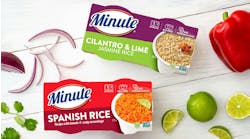"When I was first introduced to resistant starch a number of years ago, I was somewhat puzzled," says Leslie Skarra, CEO of the product development firm Merlin Development. Until that time, primary areas of fiber research were on how to find more uses for them rather than to optimize these ingredients for their health benefits. Developing an ingredient for its fiber properties, which for years the industry had been trying to get rid of, seemed counterintuitive to Skarra.
Today, resistant starches (RS) are widely used for their fiber-like health benefits, however, they also have useful functional properties. Developments in this area are rapidly advancing and a variety of resistant starches are available to solve formulation challenges.
Much good information is coming out on new RS products and their applications, concurs Sakharam Patil head of S K Patil & Associates. It's a topic Patil follows closely.
RS ingredient properties include water-binding capacity, gel-forming, viscosity, granularity of texture, clarity as well as dietary fiber and calorie contributions. But these vary greatly based on the raw material source and processing parameters. Processing factors such as pH, initial moisture and the length, degree and cycling of heat treatments have profound effects on an RS. Final health and functional properties can be made to vary as these factors are altered, an area under much research, says Patil.
High-amylose, corn-based resistant starches are some of the most common ones used commercially, notes Patil. Tapioca-, potato- and pea-starch based resistant starches also are available. Dextrin-based ingredients resistant to digestion are often included in the RS category, although technically they are maltodextrins, which are much shorter polymers than starches. Highly soluble and stable in aqueous solutions, their use is advantageous in applications such as liquids, in which low viscosity is needed.
Despite fibers' well-established health properties, some consumers shy away from fiber-enhanced foods since they are often coarser and less inviting sensory-wise than refined, processed foods. For these consumers, the use of RS is highly advantageous since there is less impact on taste, texture and color due to RS ingredients' relatively bland flavor, light appearance and small particle size.
"RS is uniquely beneficial in low-moisture products," says Skarra. "How an ingredient interacts with water, particularly its ability to hold or bind water, is very important. This is extremely true in baked goods," she adds.
Most types of fiber interact with water to some extent. However, some RS ingredients were created to minimally do so. One American Baking Institute study found two commercially available resistant starches bound less water than cellulose, oat or wheat fibers in a bread. The RS water-holding capacity was more similar to flour than fiber, says Skarra. "This is an enormous advantage in a formulator's toolbox."
Generally, RS can replace flour on about 1:1 basis. In bread applications, RS can generally replace 10-20 percent of the flour, and that amount can go higher in other applications. The actual replacement depends on factors such as the flour being displaced, type of RS and claims that are desired.
And while RS usually is more expensive than a flour, "We have found RS very cost-competitive to many fibers; they have even offered a cost advantage at times. They were chosen for other functions, but cost management was a happy benefit," says Skarra.
As interest intensifies on clean labels, how well any particular RS fits into such formulas varies. RS are categorized as RS1 (i.e., Type 1), RS2, RS3 and RS4. RS2 starches occur in starch granules and are found in potatoes, legumes and bananas. Types of RS2 and RS3 (retrograded starch molecules) that are commercially manufactured for use as an ingredient can come from either native starches or previously physically or chemically modified starches. RS3 types processed from native starches using physical (heating, cooling, drying, extrusion and/or enzymatic) steps could possibly be candidates for a "natural" product positioning. Type R4 resistant starches would likely be excluded from any natural claims due to their chemical modification steps, says Patil.
Depending on their source, RS and digestion-resistant dextrins can appear on ingredient lists as corn starch, modified starch and maltodextrin.
This article originally appeared in the June 2013 issue of Food Processing Magazine.

